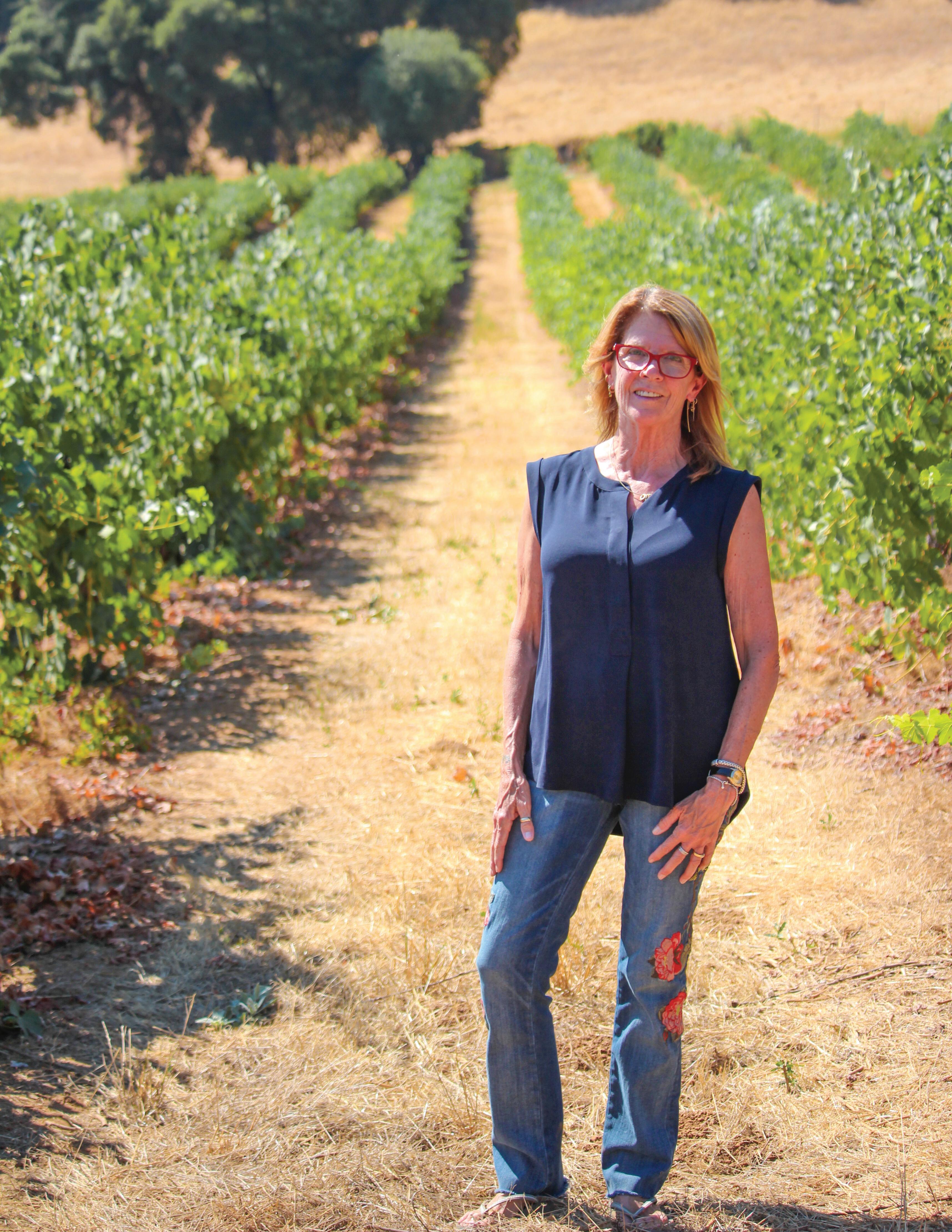
4 minute read
A Life Among the Vines
GAY CALLAN ’67
Chatom Vineyards is nestled in its own little valley in the foothills of the Sierra Nevada. Neat rows of vines spread out on either side of a loose collection of buildings, a quintessential red barn standing out as a focal point among the greens and golds of the surrounding slopes. The property is located at the center of Calaveras County, home to Mark Twain’s jumping frog and a burgeoning wine scene. Some 35 wineries and 50 vineyards, most small and familyowned, dot the region, which lies a straight shot east from Napa.
Advertisement
The number of wineries and vineyards in Calaveras County has grown exponentially since Gay Callan ’67 planted her first vines here in 1981. Now, after 40 years of growing grapes and producing wine, she’s preparing to plant her last. It’s a bittersweet moment for Callan, who was born and raised in San Francisco but adapted beautifully to the farming life. “I never thought I’d be kicking dirt,” she said, “but I have loved absolutely every part of it.”

Callan admits to being “very green” when she bought the 750-acre cattle ranch that would become Chatom Vineyards in 1980. She had earned a bachelor’s degree from UC Berkeley in sociology and criminology and a master’s degree from Sacramento State in marketing and finance, and had spent several years working for a company that leased computers and large equipment to other businesses. The money was good, but she was miserable.
Although she was a city girl, Callan was somewhat familiar with country life. Her family has owned farmland in California since her Italian ancestors immigrated to the Central Valley in the 1800s. When the opportunity came to purchase the cattle ranch, Callan was determined to give it a try, intent on planting grapevines on the property. “My dad looked at me and said, ‘I don’t think you’re doing the right thing.’ I said, ‘Give me a chance. I’ll figure out which end of the grape to put in the ground.’” Farmers from the neighboring county expressed their doubts, too. “This was a man’s world,” Callan said. She held her ground and used the best tool available to her: education. She took classes at UC Davis, reached out to people who knew the business, and began converting a portion of the ranch into a vineyard.
Callan said there were many lessons from Santa Catalina that helped her through these early years. Chief among them was the ability to work with and learn from people with different experiences. “One of the things I was able to take away from Santa Catalina was the art of dealing with different personalities. You lived with different personalities, you were taught by different personalities, and there was respect,” she said. “I totally respected what I was learning.” She also knew she could count on the network of close friends she made at Catalina. “The challenge of what I wanted to do, I was scared, but I also had people I could rely on,” she said.
In an area best known for zinfandel, Callan planted her first 21 acres with chardonnay and chenin blanc vines. For the next few years, she was solely a grower and seller of grapes—and she intended to keep it that way. But when the winery she supplied could no longer take one of the varietals she produced, she crushed those grapes to make her own wine, and the Chatom Vineyards label was born. Five years later, in 1990, she opened a winery and tasting room just outside the town of Murphys. At the time, hers was one of only a handful of wineries in the area. “We made wine in an old-world way,” she said. “I took a tremendous amount of pride in crafting wines that weren’t just about throwing out on the market. Our full-bodied reds would be in the barrel for 24 to 36 months.”
Chatom’s lineup included French, Italian, and Portuguese wines, from merlot and syrah to sangiovese and touriga. Then, as now, most of the local wine business was driven by tourists and wine club members, but Callan traveled ceaselessly to get her wines into stores across the United States. At its height, the winery produced 15,000 cases a year, and Chatom wines could be found in 11 states. Still, Callan maintained a focus on the community. For a few years in the early 2000s, with a female winemaker on board, Chatom made small batches of blends from excess grapes, with proceeds going to local chapters of heart disease and cancer organizations. The wines, dubbed “She Wines,” always sold out.
Callan, considered a pioneer of the Calaveras County wine industry, sold the winery in 2015. Wanting to slow down the “fast and furious” pace of the past 25 years, she is focused only on grape growing once more, tending a 65-acre vineyard with 13 varietals. “I’m back on a tractor,” she said. “I feel like Barbara Stanwyck.” But even from this, she’s ready to step away. The vineyard is up for sale.
Callan has few regrets about her life as a viticulturist and winery owner. She should have learned how to be the actual winemaker, she says. And she should have stopped more often to enjoy the fruits of her labor. Asked what advice she has for young alumnae in the wine industry, she offered only one thing: patience. Take time not only to craft the best wine, but to drink in your accomplishments— something she is only now doing for herself. Says Callan, “Reap the benefit of looking out at the beauty you’ve been able to create.”






